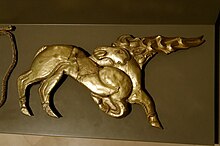عشایر کوچنشین اوراسیایی

عشایر اوراسیایی را گروههای عشایر کوچنشین تشکیل میدهند که در مناطق مختلف استپ اوراسیا زندگی کردهاند.
تاریخ عمدتاً از طریق منابع تاریخی مرزی از اروپا و آسیا آنها را میشناسد.[۱]
عشایر استپنشین هیچ اقامتگاه دائمی نداشتند، اما از جایی به جایی سفر میکردند تا چراگاه تازهای برای دامهای خود پیدا کنند. این نام عمومی شامل گروههای قومی متنوعی است که گاهی در مناطق استپ قزاقستان قرقیزستان، تاجیکستان، ترکمنستان، ازبکستان، اویغورستان، مغولستان، روسیه و اوکراین امروزی زندگی میکنند.
آنها اسب را در حدود ۳۵۰۰ سال پیش از میلاد اهلی کردند و سطح امکانات سبک زندگی عشایری را به شدت افزایش دادند،[۲][۳][۴] و متعاقباً اقتصاد و فرهنگ آنها بر پرورش اسب، اسب سواری و دامداری عشایری تأکید داشت. این معمولاً شامل تجارت با مردم ساکن در اطراف لبههای استپ بود. آنها ارابه،[۵] گاری، [۶]سوارهنظام، و تیراندازی با کمان اسب، و نوآوریهایی مانند لگام، عنان، رکاب، [۷] و زین را معرفی کردند. سرعت بسیار سریعی که نوآوریها از دشتها عبور کردند، این نوآوریها را بهطور گسترده گسترش داد، و آنها را برای کپی برداری توسط مردم ساکن در مناطق هممرز استپ در دسترس قرار داد. در طول عصر آهن، فرهنگهای سکایی در میان کوچنشینان اوراسیا پدید آمدند که با هنر سکایی متمایز مشخص میشدند.
پانویس
[ویرایش]- ↑ the Steppe در دانشنامهٔ بریتانیکا - "مردم استپ نوشته بسیار کمی را برای مورخان به جا گذاشتهاند و سوابق چینی، خاورمیانه و اروپا فقط آنچه را که در محدوده محدود در سراسر مرزهای استپی مربوطه آنها اتفاق افتاده است، نشان میدهد."
- ↑ Matossian Shaping World History p. 43
- ↑ "What We Theorize – When and Where Domestication Occurred". International Museum of the Horse. Archived from the original on 2016-07-19. Retrieved 2015-01-27.
- ↑ "Horsey-aeology, Binary Black Holes, Tracking Red Tides, Fish Re-evolution, Walk Like a Man, Fact or Fiction". Quirks and Quarks Podcast with Bob Macdonald. CBC Radio. 2009-03-07. Retrieved 2010-09-18.
- ↑ Lindner, Stephan (April 2020). "Chariots in the Eurasian Steppe: a Bayesian approach to the emergence of horse-drawn transport in the early second millennium BC". Antiquity. 94 (374): 361–380. doi:10.15184/aqy.2020.37. ISSN 0003-598X. S2CID 216205961.
[...] this article demonstrates that [...] این مقاله نشان میدهد که [...] ارابههای اولیه اروپایی نه دیرتر از اولین ارابههای اولیه خاور نزدیک باستان هستند. این نتیجه نشان میدهد که ارابهها زودتر از آنچه قبلاً تصور میشد، در استپ اوراسیا ظاهر شدند. [...].
- ↑ Haarmann, Harald (21 September 2020). "The Wheel, the Wagon, and the Chariot: Dynamics of Technological Transfer in Antiquity". Advancement in Ancient Civilizations: Life, Culture, Science and Thought. Jefferson, North Carolina: McFarland. p. 49. ISBN 978-1-4766-4075-4. Retrieved 19 October 2024.
Experiments with the wheel and the wagon were made in a natural environment that favored the free movement of wheeled vehicles, the steppes. It is especially noteworthy that technicians in those advanced civilizations that had established trade relations with the steppe people took due notice of the new technology and quickly recognized its immense potential. [...] the need for efficient transport facility beyond the use of pack animals must have been vital in communities with mobile life ways since local groups were accustomed to move from one camp site to another, depending on the seasonal movement of the herds in search of favorable pastures. Given the flatness of the steppes terrain, the innovation to introduce wheeled wagons as transport vehicles seems conclusive for such an ecological environment. [...] The time window for the origins of wheeled vehicles opens between ca. 4000 and ca, 3500 BCE. Archaeological evidence [...] comes from areas on the north-eastern periphery of the Danube civilization, dating to a period between 3500 and 3350. This area had been infiltrated by Indo-European migrants of the second out-migration from the steppes, Kurgan II.
- ↑ For example:
"Stirrups". The Applied History Research Group, The University of Calgary. Archived from the original on 18 October 2013. Retrieved 19 October 2024.
Some scholars believe that the first true stirrups were devised in Central Asia during the first century BCE by a nomadic group known as the Sarmatians. This innovation soon spread to other Central Asian peoples, who would have quickly noted that bracing one's feet in a set of stirrups made it much easier to shoot a bow from the saddle. [...] Invaders from Central Asia, such as the Huns, brought the stirrup to Europe [...].
منابع
[ویرایش]- Amitai, Reuven; Biran, Michal (editors). Mongols, Turks, and others: Eurasian nomads and the sedentary world (Brill's Inner Asian Library, 11). Leiden: Brill, 2005 (شابک ۹۰−۰۴−۱۴۰۹۶−۴).
- Drews, Robert. Early riders: The beginnings of mounted warfare in Asia and Europe. NY: Routledge, 2004 (شابک ۰−۴۱۵−۳۲۶۲۴−۹).
- Grousset, Rene. The Empire of the Steppes: a History of Central Asia, Naomi Walford, (tr.), New Brunswick, NJ: Rutgers University Press, 1970.
- Haines, Spencer (2017). "The 'Military Revolution' Arrives on the Central Eurasian Steppe: The Unique Case of the Zunghar (1676 - 1745)". Mongolica: An International Journal of Mongolian Studies. International Association of Mongolists. 51: 170–185.
- Hildinger, Erik. Warriors of the steppe: A military history of Central Asia, 500 B.C. to A.D. 1700. New York: Sarpedon Publishers, 1997 (hardcover, شابک ۱−۸۸۵۱۱۹−۴۳−۷); Cambridge, MA: Da Capo Press, 2001 (paperback, شابک ۰−۳۰۶−۸۱۰۶۵−۴).
- Kradin, Nikolay. Nomadic Empires: Origins, Rise, Decline. In Nomadic Pathways in Social Evolution. Ed. by N.N. Kradin, Dmitri Bondarenko, and T. Barfield (pp. 73–87). Moscow: Center for Civilizational Studies, Russian Academy of Sciences, 2003.
- Kradin, Nikolay. Nomads of Inner Asia in Transition. Moscow: URSS, 2014 (شابک ۹۷۸−۵−۳۹۶−۰۰۶۳۲−۴).

